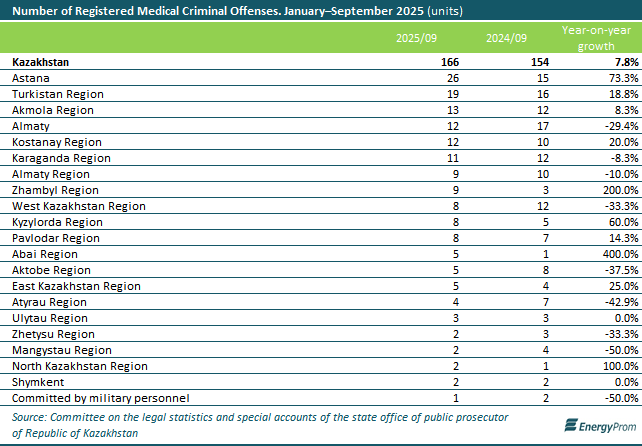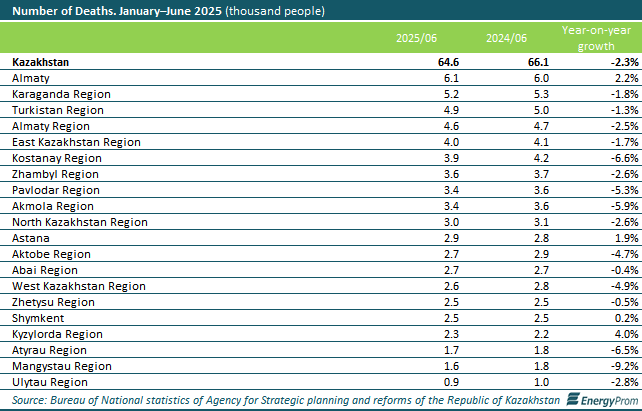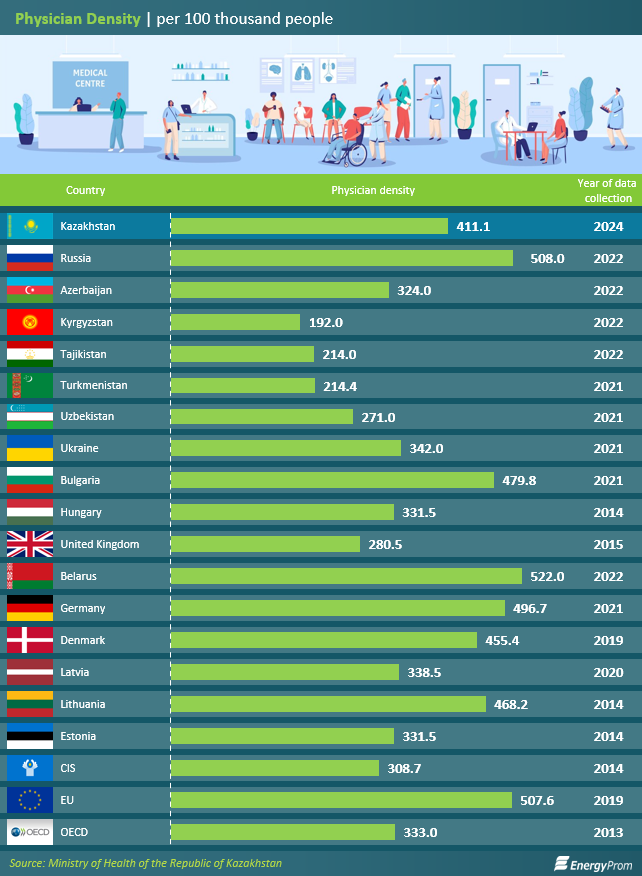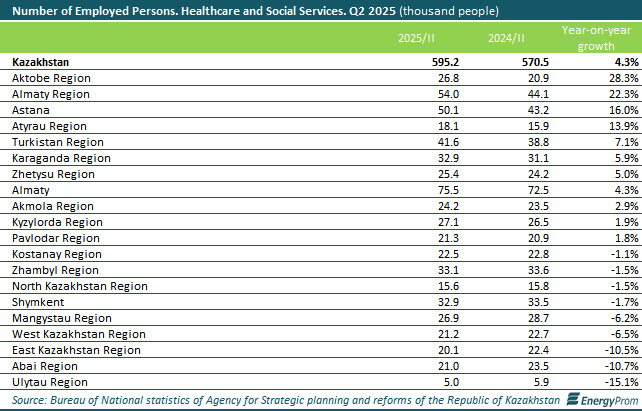What Criminal Offenses Are Most Commonly Committed by Kazakhstan’s Medical Professionals?
22 October 2025
287

In January–September of the current year, 176 people in Kazakhstan became victims of medical criminal offenses, compared to 162 in the same period of 2024 — an increase of 8.6%. The majority of victims were women — 105 people, or 59.7% of the total. Among the victims were 29 minors and 10 pensioners. In addition, one person with a disability and one convicted individual were affected by medical criminal offenses.
By age group, the victims included 22 children aged up to 11, four aged 12–13, two aged 14–15, one aged 16–17, six young people aged 18–20, 21 aged 21–29, 42 aged 30–39, 32 aged 40–49, 18 aged 50–59, and 28 aged 60 and older.
It is worth noting that since the beginning of the year, 166 medical criminal offenses have been registered in Kazakhstan — 7.8% more than in January–September 2024. The number of individuals who committed such crimes increased from 17 to 28.

As for specific articles of Kazakhstan’s Criminal Code, 87.3% of all cases in the sector were classified as medical criminal offenses under the article “Improper performance of professional duties by a medical or pharmaceutical worker” — 145 cases, up by 3.6% compared to the previous year.
In addition, 16 offenses were related to illegal medical and pharmaceutical activities, as well as to the unlawful issuance or forgery of prescriptions or other documents granting access to narcotic or psychotropic substances. Three offenses were registered under the article “Failure to provide medical assistance to a patient”, and one each under “Illegal performance of abortion” and “Handling of falsified medicines, medical products, or medical equipment.”
Regionally, the highest number of medical criminal offenses in January–September 2025 was recorded in Astana — 26 cases, compared to 15 a year earlier. The Turkistan (19 cases) and Akmola (13 cases) Regions followed. The lowest number of such offenses was reported in Shymkent, as well as in the North Kazakhstan, Mangystau, and Zhetysu Regions — two cases each.

Let us look at the causes of death among Kazakhstan’s population. In total, 64.6 thousand people died in the first half of 2025 — 2.3% fewer than in the same period a year earlier.
By major categories of causes, the leading factors of mortality were diseases of the circulatory system (15.4 thousand people), diseases of the nervous system (11.2 thousand people), neoplasms (6.9 thousand people), respiratory diseases (6.5 thousand people), digestive diseases (5 thousand people), accidents, poisonings, and injuries (4.6 thousand people), as well as infectious and parasitic diseases (489 people). It should be noted that deaths from illnesses do not imply medical error or criminal intent; the statistics are provided for reference only.
Regionally, the highest number of deaths in the first half of 2025 was recorded in Almaty — 6.1 thousand people, compared to 6 thousand a year earlier. It was followed by the Karaganda Region (5.2 thousand), Turkistan Region (4.9 thousand), Almaty Region (4.6 thousand), and East Kazakhstan Region (4 thousand). The lowest mortality figures were recorded in the Ulytau Region (933 people), Mangystau Region (1.6 thousand), and Atyrau Region (1.7 thousand).

Interesting data: as of 2024, Kazakhstan had 411.1 physicians per 100,000 people. For comparison, the average figure across CIS countries was 308.7, in OECD member states — only 333, and in the European Union — 507.6 per 100 thousand people.
Among CIS countries, the highest physician density was recorded in Russia — 508 per 100,000 people. It was followed by Belarus (522), Azerbaijan (324), Uzbekistan (271), Turkmenistan (214.4), Tajikistan (214), and Kyrgyzstan (192). In Ukraine*, the figure stood at 342 physicians per 100 thousand people.
It should be noted that the data refer to different years and are therefore not directly comparable. Details are provided in the table.
* Ukraine’s status within the CIS is disputed for a number of reasons.

In the second quarter of the current year, 595.2 thousand people were employed in the healthcare and social services sector in Kazakhstan — 4.3% more than in the same period of 2024.
Regionally, the highest number of people employed in the sector was recorded in Almaty (75.5 thousand), followed by the Almaty Region (54 thousand) and Astana (50.1 thousand). The lowest employment figures in healthcare were observed in the Ulytau (5 thousand), North Kazakhstan (15.6 thousand), and Atyrau (18.1 thousand) Regions.
Notably, although the total number of employees in the sector across the country increased, nearly half of the regions — 9 out of 20 — recorded a decline. The most significant decreases in employment in healthcare and social services were observed in the Ulytau Region (down by 15.1%), Abai Region (down by 10.7% to 21 thousand people), and East Kazakhstan Region (down by 10.5% to 20.1 thousand people). The smallest decrease was recorded in the Kostanay Region — down by 1.1% to 22.5 thousand people.
At the same time, the largest growth in employment in the sector was recorded in the Aktobe Region — up by 28.3% to 26.8 thousand people. It was followed by the Almaty Region (up by 22.3% to 54 thousand people) and Astana (up by 16% to 50.1 thousand people).

Popular articles
Watch allWho and why does Kazakhstan’s saiga antelope give trouble?
Experts question the department’s statistics, as well as decisions made at state level regarding saigas In early summer, there Читать далее...
28 June 2022
2816
Gas Production Declined, While Prices Jumped 28% Year-on-Year
In January–July of this year, natural gas production in Kazakhstan amounted to 14.8 billion cubic meters, down 10.3% compared with Читать далее...
17 September 2025
1616
Electric Vehicles Accounted for Less Than 1% of All Registered Cars in Kazakhstan
From January to July of this year, 925.8 thousand passenger cars were registered in Kazakhstan, 0.3% more than in the Читать далее...
28 August 2025
1254
Kazakh oil refineries supplied 73.3% of motor fuel consumed and 97.4% of diesel fuel consumed in the country. Petrol output increased by 10.6% and production of gasoils by 3.6%
The price of the most popular octane-93 petrol increased by 16.4% year on year to KZT125 per litre in July. The price of summer diesel increased by 3.3% year on year to KZT99 per litre
15 September 2016
1252
Power generation reaches 53.7bn kWh in January-July, up by 1.7% year on year. Gas turbine power plants with a capacity of 100,000 kW worth KZT18.6bn were commissioned in the first half of the year
Electricity tariffs went up by 5.8% year on year in August
16 September 2016
1199
Industrial enterprises navigate to sustainable development
Major industrial companies’ investments into social and infrastructure projects in 2019 exceeded 140 billion Tenge Kazakhstan has been holding Читать далее...
5 November 2021
1133
Safeguarding the nature: investment into environmental protection increased by 34% over the year
The number of fixed point sources of pollution in 10 years has increased by 58% Environmental issues are extremely Читать далее...
5 November 2021
994
Focus on ESG: the world is confidently switching to green rails and sustainable development principles
In Kazakhstan, only some of the major backbone companies, major market players, and national development institutions are ready to implement Читать далее...
5 November 2021
910
Renewable energy generation capacities goes up by 40% year-on-year in Kazakhstan in 1Q2016
Clean energy generation jumps by 130% year-on-year in this period
22 June 2016
895
“Pirating” in Kazakhstan: 59% of Young People Use Free Platforms to Watch Films and Series
According to the analytical report Youth of Kazakhstan for 2024, one of the most common leisure activities among young people Читать далее...
26 September 2025
770
Kazakhstan’s crude oil and gas condensate output fall by 3.4% year on year in January-July 2016
In July 2016 crude oil and condensate went down by 0.9% year-on-year
26 September 2016
695
Production of equipment for the oil and gas sector increases by 82.5% year on year in January-July 2016
The sector is boosted by key projects such as the launch of oil production at the Kashagan field expected in the fourth quarter of this year
1 September 2016
692
Kazakhstan’s industrial output goes down by 2.2% year on year in Jan-Apr 2016
Kostanay Region becomes regional outsider with 15.7% slump
11 July 2016
650
Output of unrefined and semi-refined gold increased by 21.5% year on year, that of refined gold by 16.5%
Jewellery prices jump by 20.1% year on year on average in Kazakhstan, by 50% in Astana
6 September 2016
632
Hotel rates increase by 11.1% year on year in June 2016, health resorts by 11.5%
The number of hotels, rest homes and other facilities to accommodate tourists increased by 12.7% in the past year
5 August 2016
608














